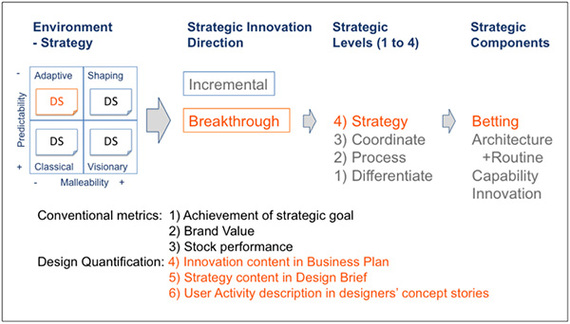Co-written by Dr. Brigitte Borja de Mozota
The effectiveness of corporate innovation strategies is hugely influenced by their position in the competitive environment and their innovation management. Fortunately, the design strategy can assist in facilitating innovation strategy, diagnosis, formulation and implementation.
Design conventionally contributes to creating value in the value chain at four levels, dependent on the design maturity of the organization. According to the DesignenceTM model these are: (1) Lowest level - by differentiating offerings, (2) second level - by streamlining the process, (3) third level - creating unique internal and external configurations and (4) top level - assisting in the creation of actionable strategies.
To plan and manage design strategy and ensure that it is responsible and accountable for its activities, relevant metrics need to be in place. When measuring design, one-size-fit-all does not apply and this kind of thinking can be directly counterproductive. Metrics need to align with the corporate strategy and the design strategy.
As an example, when Apple decided to develop the iPhone, the firm was fiercely competing in an adaptive market with low malleability and low predictability. Plenty of marketing data was available for traditional cell phones and the technology was mature with touch screens already a proven technology. Apple had gained some experience by launching a short-lived phone together with Motorola in 2005 and felt that compromising with a non-Apple designer was hurting the offering.
What Jobs then did, was to pursue a strategic disruptive innovation direction. He envisioned Apple leveraging its ability to provide excellent synchronization software by betting on cell phones becoming essential devices for portable information access. When launched in July 2007, the iPhone disrupted the entire cell phone market, driving Nokia, which had close to fifty percent market share, out of the business.
Now conventional metrics for strategy implementation are achieving strategic goals in sales, brand value and stock performance. According to these lagging metrics, Apple has done extremely well along all three metrics. The new category Smartphone, enjoyed explosive growth and Apple successfully positioned itself in synchronization software. The firm's brand value (according to Interbrand) went up by 790% from 2007 to 2013 (130% average per year) and its share price grew by 530% from January 2007 to October 2013 (82% average per year).
These metrics measure design aesthetics impact through sales and brand perception but do not speak to the design strategy used in managing the innovation necessary in order to achieve these results. We need other Design Quality Criteria content to act as early lead indicators and to be focused on innovation management. The Concept Attention Profile does this by measuring designers' design discourse focus on user activity for breakthrough innovations.
We have only indirect information access to these metrics, first, through the official autobiography on Apple's founder, Steve Jobs, by Walter Isaacson, which describes Job's dedication to making users activities easier and second, through the auditing of the Industrial Design Excellent Award (IDEA) by the Industrial Design Society of America (IDSA). Here, Apple performed about average with regard to focusing on user activities, in line with the IDEA Gold Award winners.
Metrics differ with the nature of innovation. If the firm is pursuing an incremental innovation (investing and exploiting mode) standard financial and brand metrics are useful for the Design Quality Criteria Process, Function and Expression. On the other hand, if the firm is engaged in breakthrough innovation (betting and exploring mode), context and process metrics have to be added as they are building unique inimitable capacities.
Ultimately, it comes down to how the organization is defining its strategy. Is the organization looking at design as a competitive advantage on the market or is the organization adopting a more risk-driven attitude and looking for a sustainable competitive advantage through design as a core competency? This translates into a "design you cannot see" capacity building, which is difficult to copy even when publicly available. A coherent design strategy can help organizations to effectively navigate these options.
Special thanks to Dr. Brigitte Borja de Mozota for researching and co-writing this article.
